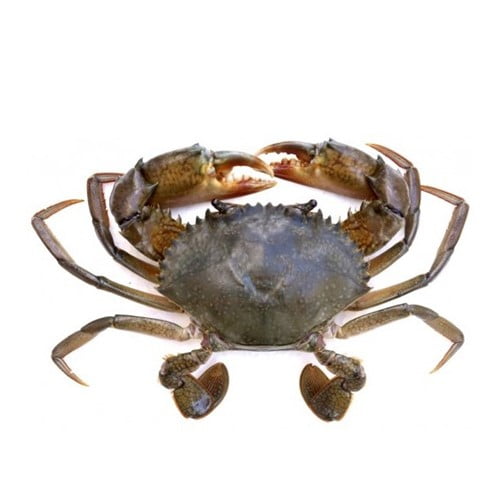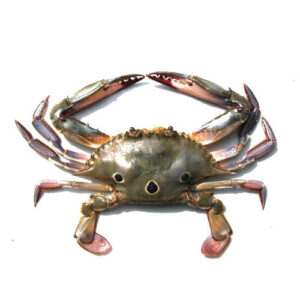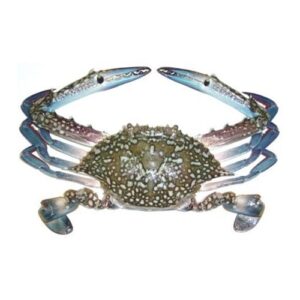Introduction
Crab (Kekra fish) consumption is not very common in Pakistan, but there are still good numbers of people who sought this highly prized delicacy of the Arabian Sea.
Since Mud crabs (Kekra) are highly demanded in the international market, 90 percent of local Mud crab catch is exported from Pakistan, but there is still some of it left for local consumption. Mud crab is famous for its larger sizes and high meat yield as compared to other locally available varieties of Crabs.
There are two variants of mud crab generally found in Pakistan. The first and most common variant is the export rejected (rejected when either of the claw is broken). These mud crabs are very economical. The second variant is the large size, export standards Mud crab which is approx. 400 to 700 grams in size and is without any broken leg or claw. However, this second variant is costly because of international demand.
Flavor Profile
The mud crab is one of the best shellfish you could wish for. Its moist meat, mostly found in the body and claws, has a marvelous distinct and sweet flavor.
Nomenclature
- English Name: Mud Crab, King Mud Crab, Orange Mud Crab
- Local Name: Kekra, Kala Kekra, Khunkhna, Kukri
- Scientific Name: Scylla olivacea
Habitat
Mud crabs are normally found in mangroves with Other Crabs.
Catching Method
They are caught using baited lines, gillnets, handpicking, and bottom trawls.
Physical Attributes
The Carapace is smooth. The front of the mud crab (Kekra fish) has four rounded and low teeth. It has 9 teeth on each anterolateral margin and the last tooth is subequal in size to others. The palm of chelipeds is usually with a pair of blunt prominences.
Appearance
The Shell of the mud crab (Kekra) is brownish to brownish-green in color.
Size
On average, Mud Crabs are 100 to 600 grams in weight, However other sizes are also occasionally available.
Peeling Preferences
Mud Crabs (Kekra fish) are preferred to be used as Whole
Approx. Peeling Yields
- Whole: 100 %
- Claws and legs removed: 70 %
- Shell Removed: 35 %
- Meat only: 15 %
Cooking Preferences
Mud Crab is preferred to Grill, BBQ, and to be used in soups and broths.
Cooking Highlights & Serving Ideas
Mud crab performs beautifully in a variety of dishes:
Signature Curries & Sauces – Think rich regional classics like Jaffna crab curry or crab in oyster sauce, mud crab perfectly carries bold flavors.
Boiled, Grilled, or Baked – Boil whole for 10–20 minutes, then grill or bake as desired. Or plunge directly into curry sauces.
Easy Prep Tips – Chill crabs on ice before cooking to gently sedate them. Then drop in vigorously boiling salty water for about 15 minutes for best results.
Health Benefits of Mud Crab
Muscle Repair & Energy – Rich in high-quality protein for building and maintaining muscle mass.
Bone & Blood Health – High levels of calcium and iron support stronger bones and red blood cell formation.
Immune Support & Antioxidants – Selenium, zinc, and antioxidant compounds enhance immune response and combat oxidative stress.
Anti‑Inflammatory & Antimicrobial Effects – Studies show protective, inflammation-reducing, and pathogen-inhibiting benefits.
Heart & Brain Health – Omega‑3 fatty acids help regulate heart function and support cognitive performance.
Mud Crab — Frequently Asked Questions (FAQ)
| Question | Answer |
|---|---|
| 1. What is Mud Crab? | Mud Crab (Scylla serrata) is a prized crustacean from the Indo‑Pacific, celebrated for its sweet, firm meat and culinary versatility. |
| 2. What makes it nutritious? | It’s a standout source of lean protein, calcium, iron, zinc, selenium, omega-3s, and antioxidants. |
| 3. What are the health benefits? | Supports muscle, bone, immune, heart, and brain health with added anti-inflammatory and antimicrobial properties. |
| 4. How can I cook it? | Excellent in curries, Asian-style sauces, grilled, boiled, or baked—you choose. |
| 5. Cooking time guide? | Boil whole for about 10–20 minutes (adjust based on size), then proceed with your recipe. Ice-chill before cooking improves quality. |
| 6. Can I eat all parts? | Yes—meat is found in claws, legs, and body; discard gills and internal organs. |
| 7. How do you package and deliver in Karachi? | We ensure hygienic handling with chilled packaging and fast, fresh delivery to your doorstep. |
| 8. How should I store it? | Keep in the fridge and use within 24 hours. For longer shelf-life, freeze in airtight packaging. |
| 9. Is mud crab sustainable? | When responsibly sourced, it’s a respected and sustainable seafood choice. |
| 10. Can I order online? | Yes—select whole or cleaned options online, and we’ll deliver directly in Karachi. |





There are no reviews yet.